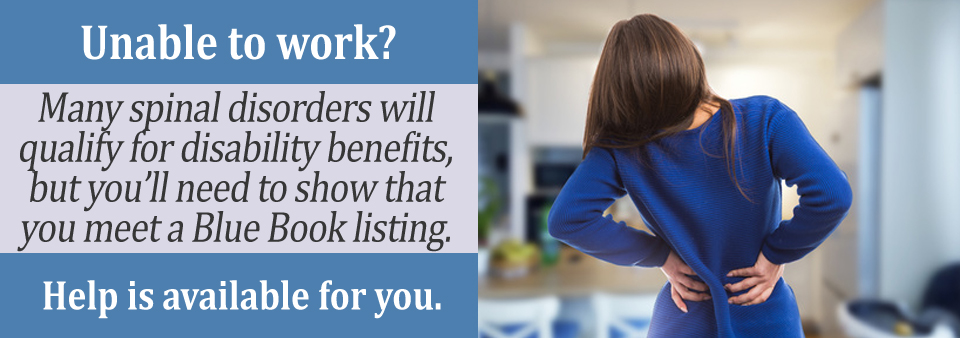If you have a spinal disorder that has left you unable to work, you might be eligible to receive Social Security Disability benefits. The Social Security Administration (SSA) oversees disability benefits for disabled workers. Specific medical criteria must be met, and the individual must be 100% disabled as no partial disability benefits are awarded.
There are three ways to get your disability claim started. You can go to www.ssa.gov and start the application, you can call 1-800-772-1213, or you can visit your local SSA office and meet with a representative face to face and start the process in person. Regardless of your approach, medical documentation and hard evidence are the keys to a successful claim.
Getting Disability Approval With Spinal Problems
There are some spinal problems that warrant an approval for monthly disability benefits from the SSA.
Nerve Root Compression – This is a challenging listing to meet, although the listing does not require you to have an MRI with hard evidence showing nerve root impingement. This condition causes the weakening or atrophy of muscles, limits your range of motion, causes radiating pain, and dulls your senses and reflexes.
Spinal Stenosis – This condition causes narrowing of the spinal canal which results in compression of the nerves and spinal cord. While a ruptured or bulging disc can cause this condition, it is usually a result of the aging process. It can occur in the cervical and lumbar spine regions. This condition automatically qualifies for disability benefits if you have pain in your buttocks, thighs, and lower back with lower extremity weakness; have continuous non-radicular pain; have a CT scan or MRI that confirms lumbar spine stenosis; and not able to walk without someone’s assistance, a walker or two crutches.

Spinal Arachnoiditis – This condition results from an inflammation of the arachnoid, which is a membrane that surrounds and protects the spinal cord. Your claim must have a pathology report of a biopsy, an imaging test result, or an operative note that indicates the thickening and swelling of the roots of the nerve.
Ankylosing spondylitis – To be approved for this condition, which can be considered an autoimmune disorder, a form of inflammatory arthritis, a kind of rheumatic disease, or one of the various spondylarthropathies, it is an inflammatory condition that can affect various body parts. To be approved for disability benefits, you must have a scan that shows fixation of the cervical spine or dorsolumbar at 45.
Bulging or Herniated disc – A bulging or herniated disc is a common back condition that is caused by pressure being put on an intervertebral disc that causes a disc to protrude. This is painful condition that affects mobility. Often, it can be challenging to be approved for disability with this condition because these disc issues often resolve themselves within a year or they are fixed by a surgical procedure.
Consult With a Disability Attorney
If a spinal condition is keeping you from working, you should consult with a Social Security disability attorney. Your odds of having your claim approved increase significantly with an attorney’s help. Get your free case evaluation today.